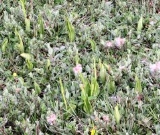
Ophioglossum vulgatum
Encyclopedia
Ophioglossum vulgatum, commonly known as the Southern adderstongue, is a species of the plant
genus Ophioglossum
. It is native to temperate regions of the Northern Hemisphere
, with a scattered distribution in Europe
, Asia
, northwestern Africa
, and eastern North America
.
This plant grows from a rhizome
base to 10-20 cm tall (rarely to 30 cm). It consists of a two-part frond
, separated into a rounded diamond-shaped sheath and narrow spore
-bearing spike. The spike has around 10-40 segments on each side. It reproduces by means of spores.
Traditional European folk use of leaves and rhizomes as a poultice for wounds. This remedy was sometimes called the "Green Oil of Charity". A tea made from the leaves was used as a traditional European folk remedy for internal bleeding and vomiting.
This small, hard-to-spot plant occurs singly in un-improved pastures, rock crevices and grassy path-sides but also occurs in colonies of hundreds of plants in sand dune slacks.
Plant
Plants are living organisms belonging to the kingdom Plantae. Precise definitions of the kingdom vary, but as the term is used here, plants include familiar organisms such as trees, flowers, herbs, bushes, grasses, vines, ferns, mosses, and green algae. The group is also called green plants or...
genus Ophioglossum
Ophioglossum
Ophioglossum is a genus of about 25-30 species of Ophioglossales in the family Ophioglossaceae, with a cosmopolitan but primarily tropical and subtropical distribution. The name Ophioglossum comes from the Greek, and means "snake-tongue".Adders-tongues are so-called because the spore-bearing stalk...
. It is native to temperate regions of the Northern Hemisphere
Northern Hemisphere
The Northern Hemisphere is the half of a planet that is north of its equator—the word hemisphere literally means “half sphere”. It is also that half of the celestial sphere north of the celestial equator...
, with a scattered distribution in Europe
Europe
Europe is, by convention, one of the world's seven continents. Comprising the westernmost peninsula of Eurasia, Europe is generally 'divided' from Asia to its east by the watershed divides of the Ural and Caucasus Mountains, the Ural River, the Caspian and Black Seas, and the waterways connecting...
, Asia
Asia
Asia is the world's largest and most populous continent, located primarily in the eastern and northern hemispheres. It covers 8.7% of the Earth's total surface area and with approximately 3.879 billion people, it hosts 60% of the world's current human population...
, northwestern Africa
Africa
Africa is the world's second largest and second most populous continent, after Asia. At about 30.2 million km² including adjacent islands, it covers 6% of the Earth's total surface area and 20.4% of the total land area...
, and eastern North America
North America
North America is a continent wholly within the Northern Hemisphere and almost wholly within the Western Hemisphere. It is also considered a northern subcontinent of the Americas...
.
This plant grows from a rhizome
Rhizome
In botany and dendrology, a rhizome is a characteristically horizontal stem of a plant that is usually found underground, often sending out roots and shoots from its nodes...
base to 10-20 cm tall (rarely to 30 cm). It consists of a two-part frond
Frond
The term frond refers to a large, divided leaf. In both common usage and botanical nomenclature, the leaves of ferns are referred to as fronds and some botanists restrict the term to this group...
, separated into a rounded diamond-shaped sheath and narrow spore
Spore
In biology, a spore is a reproductive structure that is adapted for dispersal and surviving for extended periods of time in unfavorable conditions. Spores form part of the life cycles of many bacteria, plants, algae, fungi and some protozoa. According to scientist Dr...
-bearing spike. The spike has around 10-40 segments on each side. It reproduces by means of spores.
Traditional European folk use of leaves and rhizomes as a poultice for wounds. This remedy was sometimes called the "Green Oil of Charity". A tea made from the leaves was used as a traditional European folk remedy for internal bleeding and vomiting.
This small, hard-to-spot plant occurs singly in un-improved pastures, rock crevices and grassy path-sides but also occurs in colonies of hundreds of plants in sand dune slacks.

